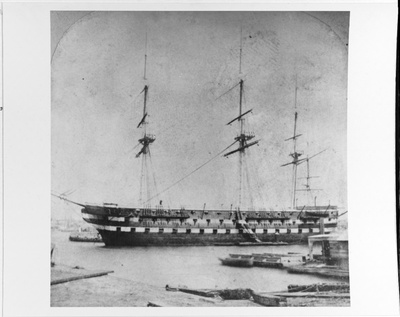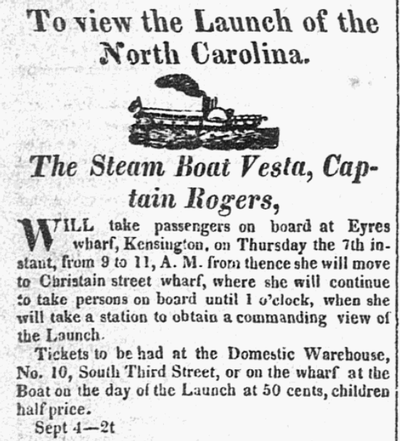Looming from behind a glass case and wood framing in Parkway Central Library's Social Sciences and History Department is an accurate model of the USS North Carolina, a 74-gun ship of the line. While the oversized model was meticulously crafted in 1840 by an unknown New York sailor, the actual ship is much older. USS North Carolina is an early example of expert shipbuilding for the United States Navy, built in Philadelphia at the nation’s first official shipyard.
Why did the United States need such deadly force on open seas? After all, early 1800s America was at peace, with the Continental Navy and Marine Corps having been reduced in size for some time. However, America was also a neutral trader between warring European nations. Merchants were awash in products from all the states and wanted to sell to whoever had money. In attempts to trade, American merchants were ransacked by Barbary pirates off the coast of North Africa, and even Great Britain and France joined the chaos to weaken each other’s supply lines. Starting in 1794, U.S. Congress authorized the building of six frigates, and under further authorization, sloops and gunboats were constructed to keep trade peaceful. These actions had little effect, especially against Great Britain, the world’s largest navy. The United States then introduced punitive trade embargoes against Great Britain and France, but again, with unfavorable results. When France relented and began trading with Americans again, it led to the British impressment of American sailors and the confiscation of cargo.
The United States then entered conflict with Great Britain during the War of 1812. The war resulted in the production of ships of the line, so named because they fired their cannons from the broadsides as they passed other ships in battle. Although none of the first ships of the line were completed before the war’s end, the efforts showed Americans' renewed desire for maritime defense. The War of 1812 ended, and so did Great Britain’s war with Napoleonic France. America was left undisturbed to continue building its Navy’s size throughout the 1820s. As ships of the line entered service, international sea trade was safeguarded.
In 1824, North Carolina was the third 74-gun ship of the line completed. Joshua Humphreys, known as the father of the American Navy, oversaw the construction of the North Carolina in 1819, with the work of 40 ship carpenters, mechanics, and laborers. The original Philadelphia Navy Yard (established in 1801) comprised an area of about 17 acres just below Old Swedes Church at the corners of Washington Avenue and Front Street. Iron steamships required a larger area of land for construction, and the Navy Yard was relocated to League Island, Philadelphia, in 1875.
Once North Carolina was fitted with cannons, it was under the initial command of Commodore John Rodgers. Its objective was to lead a squadron of Navy ships that supported diplomacy and trade between nations. The impressive number of cannons it held was an implicit show of force should trade be jeopardized. Without ever seeing a real battle at sea, it dutifully carried out important missions: opening new trade with Turkey, navigating Mediterranean waters, and protecting American trade while Chile and Peru were at war. It returned to the U.S. and anchored in the New York Navy Yard in 1839, where it served as a receiving ship until 1865.

Rare photo of the North Carolina as a receiving ship in the New York Navy Yard during the 1860s
Credit: Naval History and Heritage Command
USS North Carolina Facts:
- North Carolina was an entirely wooden sailing ship.
- Its tonnage was 2,633 tons.
- The ship’s length was 196 feet 3 inches (or 59.8 meters). At its widest, it was 53 feet 6 inches (or 16.3 meters).
- The ship had room for up to 820 people.
- The most common type of cannons on the ship were known as pounders. There were 34 42-pounder and 36 32-pounder cannons.
- Pounders could reach ranges of over 2,000 yards. For comparison, that’s over 20 football fields in length.
- The remaining cannons were known as Carronades.

Franklin Gazette, vol. V, no. 775, 5 Sept. 1820, p. [3]. Retrieved from: America's Historical Newspapers Database
Further Reading:
- Bruce, A. P. C., and William B. Cogar. An Encyclopedia of Naval History. New York: Facts on File, 1998.
- Dorwart, Jeffery M., and Jean K Wolf. The Philadelphia Navy Yard: From the Birth of the U.S. Navy to the Nuclear Age. Philadelphia: University of Pennsylvania Press, 2001.
- Jenkins, Mark Collins, and David Taylor. The War of 1812 and the Rise of the U.S. Navy. Washington, D.C.: National Geographic, 2012.
- Naval History Division, et al. American Ships of the Line. Washington: U.S. Government Printing Office, 1969.
- Silverstone, Paul H., and Ian W. Toll. The Sailing Navy, 1775-1854. Annapolis, Md.: Naval Institute Press, 2001.
Have a question for Free Library staff? Please submit it to our Ask a Librarian page and receive a response within two business days.

